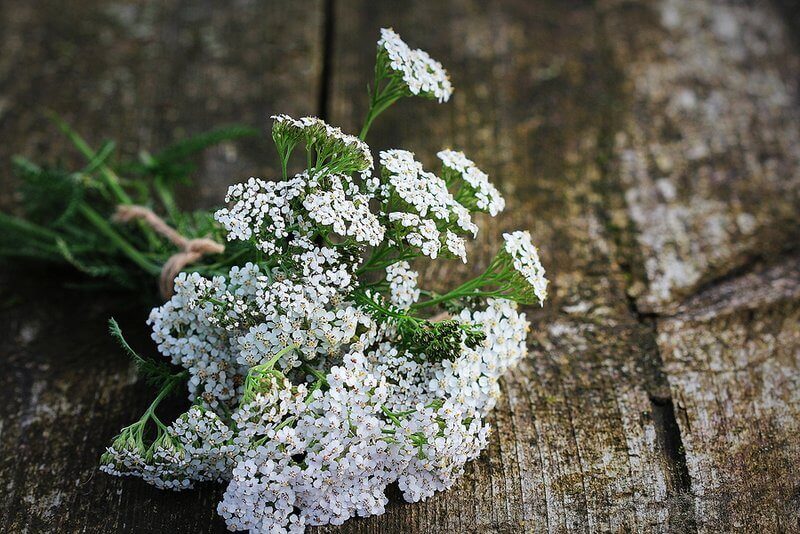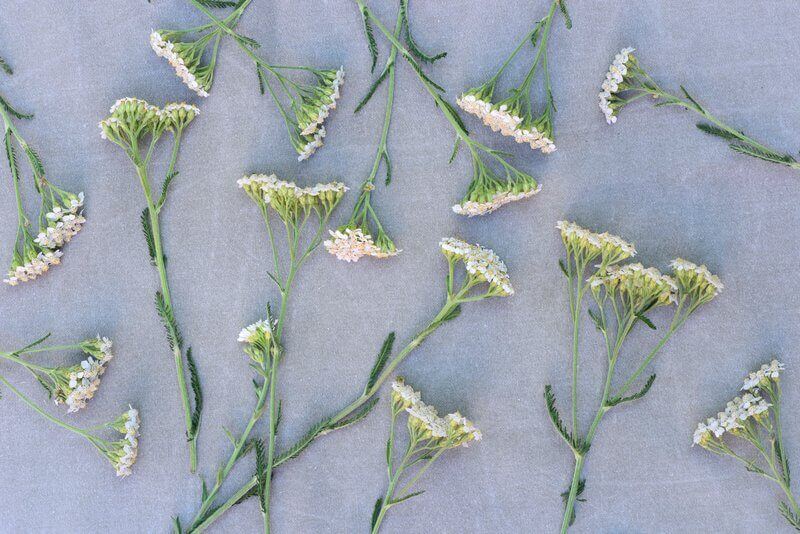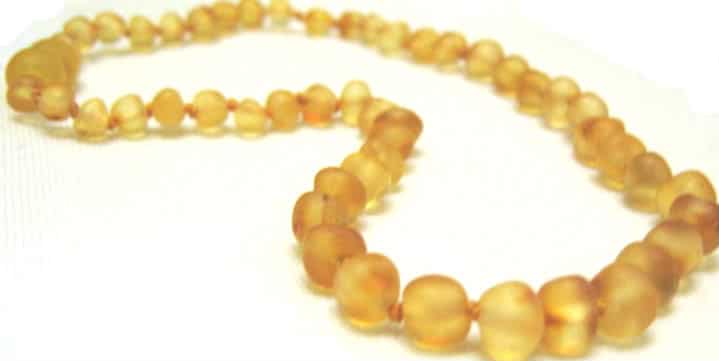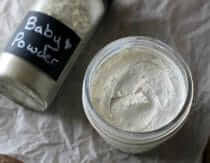
Old Man’s Pepper. Soldier’s Herb. Knight’s Milfoil. Thousand Weed. Nose Bleed. <<– Yarrow has a colorful list of names, and an even richer and more colorful history of use in European, Native American, and Chinese medicine. The ancients called it Herbe Militaris – the Military Herb – because it was often used to staunch bleeding and support wound healing.
If you’re thinking that your battle wounds look more like homemade ketchup stains and you don’t usually need to staunch bleeding, keep reading. Yarrow is useful for so much more than just wound care – according to the revered Bavarian priest and herbalist Father Sebastian Kneipp, “Women could be spared many troubles if they just took yarrow tea from time to time!”(Treben)
In fact, when you ask an herbalist to choose their favorite herb out of all the hundreds and thousands of medicinal gifts available to them, it’s usually an impossible task. However, herbalist Rosalee de la Foret once said that yarrow (Achillea millefolium) is the one plant she would take with her if she was stranded on a deserted island! (HWR)
What are the benefits of yarrow?
Yarrow is one of several herbs that herbalists call “amphoteric”. This term is borrowed from chemistry, where it is used to describe a substance that can both increase and decrease the pH of a solution.
In herbalism, it is used to describe a plant with seemingly opposite actions. For example, yarrow is known both as a hemostatic (stops the flow of blood) and a diffusive (blood moving) herb. This bidirectional action on blood flow explains how it achieves the multitude of actions listed below.

How can the same herb have opposite actions?
If you are used to the “one extreme action” of pharmaceuticals, this “amphoterism” seems quite mysterious, and perhaps even implausible. However, if you consider that there are thousands of constituents in herbs, most unknown to us, it becomes a little easier to imagine that when we consume or use whole herbs, the body takes what it needs to accomplish what is required for healing. This in part explains the amphoteric nature of yarrow.
However, herbalist Sam Coffman offers another explanation. He posits that yarrow appears to support clotting in wound healing by the exact same mechanism with which it works on moving the blood in, say, varicose veins: by breaking up stagnation and supporting the movement of new blood cells to the area, thus speeding up the healing process. (Coffman)
So, while from our perspective yarrow may appear amphoteric (both clotting and moving blood simultaneously), at the cellular level it may be accomplishing both things with just one approach – to help break up stagnation and support the creation of new healthy cells (aka: angiogenesis), thus expediting the healing process.

8 Yarrow Uses And Benefits
There are so may ways yarrow can be used, it’s no wonder Rosalee wants this herb deserted with her on that island.
#1 – Yarrow Tea (Hot) Or Tincture For Fevers
“Fevers are our friend” is longstanding wisdom in the herbal tradition. Now, modern medicine is taking the same view.
“Fever is the body’s normal response to infection — it’s a natural defense mechanism,” Dr. Janice Sullivan, a professor of pediatric clinical care and clinical pharmacology at the University of Louisville School of Medicine, told The Washington Post.
She explains that a high temperature triggers the body’s production of infection-fighting white blood cells, which inhibits the growth of viruses and bacteria, and that “If you lower the fever, you may be affecting the body’s ability to respond to that infection.”
I’ve written before about how to treat a fever naturally by supporting the body, and also discussed guidelines from a pediatrician on when to go to the doctor. Yarrow is one of the remedies mentioned in that post, and for good reason:
This plant is a do-it-all for flu and fever! Yarrow is both an anti-inflammatory as well as being antimicrobial. It reduces pain, is an anti-catarrhal, relaxes circulation, and is a mild sedative, too.” – The Herbal Academy
You’ll find a recipe for yarrow tea below.

#2 – Yarrow For Digestive Support
The Cherokee, Gosiute, Iroquois, and Mohegan nations have traditionally used yarrow for digestive support, which makes since because bitter, aromatic herbs help digestion by stimulating the production of bile and pancreatic juices. (Kruidwis)
When used internally, yarrow’s bitterness increases digestion as well as the absorption of nutrients by the body. The astringent gifts of yarrow makes her very useful in stopping diarrhea. . . The bitter properties of yarrow invigorate the liver and help it release bile while the antispasmodic gifts (an agent that relieves spasms or cramps) help in relieving cramps arising out of tensions, wind, colic, or nervous digestion.” (Sobo)
Yarrow is most often taken as a tea or a tincture to support digestion and soothe stomach aches. I like to mix it with other bitter herbs – dandelion root and catnip for example – to make “tummy tea” when my kids need it.
#3 – Yarrow For Headaches
The anti-inflammatory properties of yarrow are thought to be helpful for dull, pounding headaches or migraines that seem to drag on.
Modern research has confirmed the historical use of yarrow to relieve pain caused by a broad range of conditions. Yarrow teas and tinctures contain salicylate-like derivatives such as stigmasterol and beta-sitosterol that reduce the inflammatory process, which may accelerate healing. These compounds stop the formation of enzymes necessary for a series of chemical reactions that cause inflammation and pain.
Yarrow also contains compound designated sesquiterpene lactones, which reduce the action of pain-provoking hormones, the prostaglandins.” (Balch)
#4 – Yarrow Poultice, Compress, Or Salve For Wounds
Scottish Highlanders still make an ointment from yarrow to apply to wounds, which makes sense given it’s pain-relieving and healing properties.
Containing anti-inflammatory and antiseptic oils, as well as astringent tannins and resins, yarrow possesses excellent wound healing gifts. and also contains silica, which will help in repairing damaged tissue.” (Sakellaridis)
The anti-oxidant and cytoprotective properties of yarrow leaves and flowers may also play a role in wound healing.

How To Use Yarrow For Wound Care
Wound Powder – Dried, powdered yarrow can be applied after wounds are cleaned. Dried yarrow can also be used to make wound healing salves.
Yarrow Tea – Can be used as a wash for cuts and scrapes. (Recipe later in this post)
Poultice or Compress – If you’re wondering about the difference, a poultice is made from the whole herb and a compress is made from an extract like a tea or tincture. You’ll find instructions for making both later in this post.
Infused Oil – Herbal constituents (aka beneficial components) can be extracted using many kinds of mediums: water, alcohol, oil and others. Water based extracts – like this Happy Adrenal Tea – are usually consumed internally, although occasionally they are used externally for issues like skin or eye irritation.
Oil extractions are most often used externally. Also known as infused oils, herbs extracted using oil can be made in a number of ways. I’ll link to a tutorial below on how to make them.
Important note: Infused oils are very different from essential oils. Infused oils use a carrier oil to extract components of the whole plant, while essential oils only extract the light aromatic compounds found in the plant.
Yarrow Salve – Also known as a healing balm, this preparation is a favorite with herbalists.
#5 – Cardiovascular Support
Because it’s an astringent, yarrow is often used to tone veins, which can be helpful for varicose veins and/or hemorrhoids. The blood moving (vasodilation), cytoprotectant and anti-oxidant properties of yarrow leaves and flowers also make it supportive of overall heart health.
#6 – Yarrow Tea (Cold) For Urinary Support
Yarrow is diuretic, and is therefore a wonderful “carrier” to include with urinary antimicrobial herbs for UTIs and other urinary issues to make sure those herbs get to the urinary system. More on natural remedies for UTI’s here.
#7 -Yarrow Tea For Postpartum And Menstrual Support
“Women could be spared many troubles if they just took yarrow tea from time to time!” – Bavarian priest and herbalist Father Sebastian Kneipp (Treben)
Yarrow tea is both blood moving (if you need to get things flowing) and astringent (which is why it’s a used in this healing postpartum bath sitz recipe). Yarrow has also been shown to reduce menstrual-related discomfort. (ULP)
#8 Yarrow For Skin And Hair
Yarrow leaf facial steams can be helpful for clogged pores and yarrow tea as a hair rinse for dry or itchy scalps. You can also drink some of the tea before your shower to achieve any of the therapeutic health benefits above, and even soak a cloth in the tea and lay it over your closed eyes for a headache; look at you multi-tasking!
How much yarrow should I use?
At this point, I know you are reaching for that yarrow! Herbalist Rosalee de la Foret recommends the following adult doses:
- Yarrow tea: 1tsp/8ounces of water steeped 30 minutes, up to 3-9g/day
- Fresh yarrow plant tincture of 1:2 ratio in 95% alcohol, 2-5mL/day
- Dry yarrow plant tincture of 1:5 ratio in 40% alcohol, 2-5mL/day
How To Make Yarrow Tea
Add 1 teaspoon of dried yarrow flower to one cup of boiling water. Cover and steep for 30 minutes, then strain and serve.
Note: I use this basket tea infuser because it comes with a cover for steeping and it makes straining super simple.
How Make Yarrow Tincture
You can buy yarrow tincture here, or you can make your own 1:5 tincture (as recommended above) using the method below.
Mix 1 ounce dried yarrow (by weight) with 5 ounces (by volume) of 80 proof or higher alcohol and allow it to infuse for six to eight weeks. Strain and store in a dark glass dropper bottle.
How To Make Yarrow Salve
Yarrow flowers can be infused in a carrier oil using the exact same process as this calendula infused oil tutorial. It can be directly applied to wounds or used as a base for a healing salve. To make a salve, use the same method as described in this calendula salve recipe.
How To Make A Yarrow Poultice Or Compress
The easiest way to make a poultice is to mix just enough hot water with ground yarrow to make a paste, then apply it to the area. If you have dried herb that is not ground, you’ll need to mash it up a little to make the paste . . . some people opt to do this by chewing it, and others use a mortar and pestle.
To make a compress, simply dip a cloth in strongly brewed tea or a tincture and apply to the area.

Growing Yarrow
Yarrow grows everywhere the sun shines. It isn’t picky about soil or water, and is a great addition to your yard or balcony. If you can’t fit it in, yarrow is easily harvested from the wild – just make 100% sure you have the right plant and that the area is clean of toxins. You can use every part of the yarrow plant, but it is best to leave the root if possible.
Yarrow Safety And Contraindications
Yarrow is in the aster (ragweed) family, so use cautiously if you have a known allergy. Some people also have a skin allergy to the sesquiterpene lactones, so start with a little to make sure you don’t have any issues.
Is yarrow safe for pregnancy and breastfeeding?
Yarrow is a uterine stimulant and emmenagogue and should not be used internally during pregnancy. Yarrow has also not been proven safe for breastfeeding.
Want more research-backed natural remedies?
No problem, I’ve created a free ebook for you – Kitchen Apothecary: 25+ Natural Remedies Using Ingredients From Your Pantry – as a gift for signing up for my newsletter. You’ll also get updates when I post about safe essential oils for pregnant/breastfeeding mamas, exclusive gifts and coupons (I was able to give away a jar of free coconut oil to anyone who wanted it recently!), plus other goodies.
Sign up using the form below.
This article was medically reviewed by Madiha Saeed, MD, a board certified family physician. As always, this is not personal medical advice and we recommend that you talk with your doctor.
Got a question about yarrow?
Please leave it in the comments below!
About the authors: This article was coauthored by Heather Dessinger and Dr. Lori Valentine Rose (PhD). Dr. Rose, PhD is a college biology, nutrition, herbal, and wellness instructor, Certified Nutrition Professional (CNP), Registered Herbalist with the American Herbalist Guild, and is Board Certified in Holistic Nutrition. She created, developed, and instructs the Hill College Holistic Wellness Pathway, the most thorough, affordable, degreed wellness program in the country. She loves spreading love and light, and helping others feel awesome on the inside and out so they can live their dreams and make this world more awesome!




